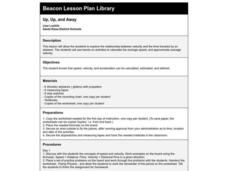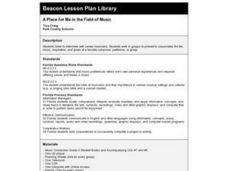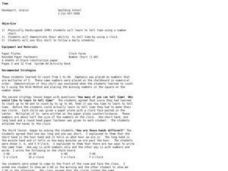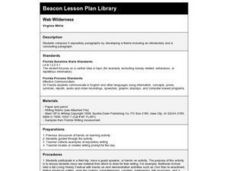Curated OER
Do They Play Sports in Costa Rica?
Young scholars use the Internet to discover what types of sports the people of Costa Rica play. They write a paper in English but must use at least one Spanish quote. In the paper they compare/contrast sports in Costa Rica and the United...
Curated OER
Up, Up, and Away
Learners study the concepts of speed and velocity and complete practice problems. In small groups, students fly airplanes and record time and distance traveled for each flight. They calculate the speed and velocity of their plane for...
Curated OER
Geometry: Tessellations
Students create tessellations with computer software while applying their knowledge of reflections, rotations, and translations.
Curated OER
Perfectly Puzzling Pentominoes
Second graders utilize manipulatives (pentominoes) to demonstrate knowledge of: lines of symmetry, slides, reflections (flips), rotations (turns), area, and perimeter. This lesson gives students a meaningful way to practice these...
Curated OER
Eye No the Write Won!
Second graders practice with synonyms, antonyms, and homophones. After listening to a Berenstain Bears story, 2nd graders utilize worksheets imbedded in this plan to gain practice identifying these parts of speech. A nice lesson!
Curated OER
Castle/Fort Unit
Young scholars compare and contrast castles and forts. They observe buildings in their community and consider how castles and forts are similar. They design their own castle or fort and brainstorm materials to build with, discuss how the...
Curated OER
Greek Vase Painting Project
Students identify the cultural context of ancient Greek, and especially Athenian, vase painting and the range of vase painting depictions of daily life and mythology. They experience the artistic and technical process of creating Greek...
Curated OER
Earth Changes
Young scholars explore the make-up of the earth and the changes it undergoes in an earthquake. In this earth science lesson, students have two activities as part of a unit. First, to use a Styrofoam ball to model the earth's structure,...
Curated OER
A Place for Me in the Field of Music
Second graders listen to interviews with career musicians. They, in groups, present to classmates the life, music, inspiration, and goals of a favorite composer, performer, or group.
Curated OER
Enzymatic Action
Students observe how a cell uses an enzyme to rid itself of a poisonous substance by experimenting with hydrogen peroxide, potatoes, liver and carrots. They record the temperature and changes of the hydrogen peroxide as other elements...
Curated OER
Where is Here?
Students are shown the very basics of navigation. The concepts of relative and absolute location, latitude, longitude and cardinal directions are discussed, as well as the use and principles of a map and compass.
Curated OER
Gingerbread Baby v. Gingerbread Boy #7
Students read two stories. In this comparison lesson, students read "The Gingerbread Baby," by Jan Brett and the original "Gingerbread Boy." Students use a Venn Diagram to compare and contrast the two stories.
Curated OER
An Internet Exploration: Flying into the Eye
Take a virtual field trip into the eye of a hurricane. Through a series of websites, mini-meteorologists discover the anatomy of a hurricane and how one is formed. Add some excitement to your atmosphere curriculum by exploring this form...
Curated OER
The Mitten
Explore the Ukraine through a reading of The Mitten. Readers will determine the sequence of events, cause and effect, make predictions, and find the main idea of the story. They also use math skills to make charts and graphs. Finally,...
Curated OER
EMH Time Lesson
Tell time using a number chart! Elementary schoolers of all ages demonstrate their ability to tell time by using a clock. They use this skill to follow a daily schedule.
Curated OER
Do the Tallywalker
Students study the basics of mapmaking, then make a tally walker, (geographic location device used in secret).
Curated OER
Foreign Policy Simulation
High schoolers role play to solve various foreign policy problems. They explore how various elements of the US foreign policy system operate and practice in conflict resolution.
Curated OER
Web Wilderness
Fourth graders write an expository paper using notes taken during a field trip or a guest speaker.
Curated OER
Changing Energy: Landforms and Dance
Third graders choreograph a dance to represent the changes in nature. In this dance and nature lesson plan, 3rd graders use sharp quick movements to demonstrate changes.
Illustrative Mathematics
Teen Go Fish
Kindergartners play the classic game Go Fish as they practice identifying numbers in the teens. A fun and engaging activity that develops number recognition skills in young learners. As added support, provide cards that include both the...
Curated OER
Amazing Bird Adaptions--Why Am I A Bird?
Fourth graders identify and classify birds found in Illinois. Using the internet, they discover how birds have adapted over time and how the adaptations have increased their life span. They compare and contrast the various adaptations...
Curated OER
Noncombatancy and the Seventh day Adventist Church
Upper graders investigate how the Seventh Day Adventists are objectors to the practice of war. The lesson covers the Civil War and examines the church's position about the practice of war. The research extends to modern wars and learners...
Curated OER
Compare and Contrast Two Settings in One Text
Look for the signal words! Scholars get both instruction and practice comparing and contrasting. Although it is completely scripted, it can also serve as a detailed outline. Demonstrate this as you read a passage (included) and search...
Curated OER
Dino Fossils
Primary paleontologists discover the information they can gather from examining fossils. They place pictures in the correct sequence showing how an animal becomes a fossil. They discuss which sediments would preserve fossils better as well.

























